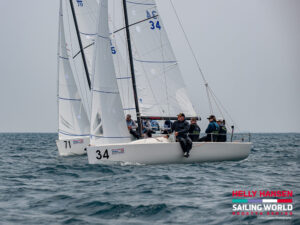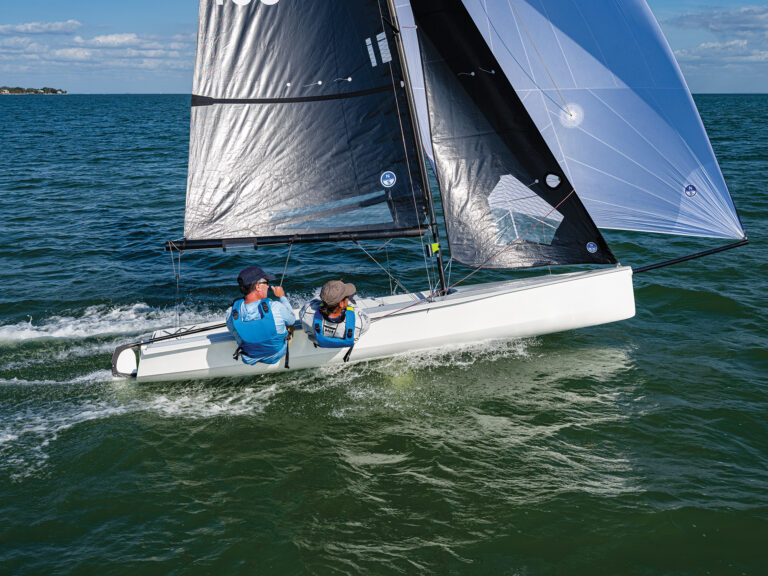
Sailboat Racing Start With Keep-Off Buoy
For the final installment of our series on the important changes to the new racing rules, we’ll tackle a few common definitions, starting with the word Finish. Changes made in 2013 to the definition Finish solved two problems. Suppose that last year a boat touched a finish line mark as she crossed the line. Then, she took a One-Turn Penalty, sailed to the course side of the line, and crossed the line a second time. In the time between her first and second crossing of the line, four other boats finished. Last year’s definition said: “A boat finishes when [she] … crosses the finishing line … either for the first time or after taking a penalty.” Which of her two crossings of the line counted as her actual finish? It was not clear. The wording of the definition has been changed so that it now works as intended—her second crossing is the one that counts.
Last year’s definition required boats to finish by crossing the line “in the direction of the course from the last mark.” The intent of those words were to make finishes orderly by requiring boats to finish by sailing straight across the line and not by “hooking ’round” one end of the line. That wording in the old definition created uncertainty when some courses were used. Here are two examples. First, suppose that the last rounding mark of a windward-leeward course was the leeward mark, but in addition to rounding the leeward mark, boats were required to pass offshore of Bell Buoy No. 3 off Rocky Point as they sailed to the finish line. Many boats satisfied that requirement without going anywhere near Bell Buoy No. 3. Which mark was the last mark—the leeward mark or Bell Buoy No. 3? It wasn’t clear.
Next, take a look at the second diagram, showing the course to the finish line in a hypothetical race. Boats were required to round the leeward mark, then beat to windward until they could bear off around a point of land and run down to the finish. In which direction should boats cross the line? Again, this was unclear under the old definition.
The new definition requires boats to cross the line “from the course side.” I think this new wording will solve both problems described above, and in addition, it is consistent with the wording in Rules 29, 30, and 44.2, all of which refer to “the course side” of either the start or finish line.

A course in which, under the old definition of Finish, it was unclear in which direction boats were required to cross the finishing line.
Definition of a mark
Committee boats are often privately-owned boats loaned by somewhat apprehensive owners who hope that their boat will survive unscathed as a fleet of racing boats maneuvers for the best spots on the starting line. A change was made in the definition Mark to allow the use of a simple device that helps prevent damage to a committee boat. Last year the definition stated that an object “temporarily attached to a mark is not part of it.” That provision was deleted from the 2013 definition.
The deletion enables race committees to stream a “keep-off” buoy astern from the committee boat on a 20- or 30-foot-long line and to write a sailing instruction stating that the buoy and line attaching it to the committee boat are parts of the mark. This forces boats to pass astern of the keep-off buoy as they approach the line and reduces the chances of a barging boat colliding with the committee boat. Using a keep-off buoy under last year’s definition Mark created a tangle of rules problems. Because the buoy and its line were temporarily attached to the committee boat, they were not part of it and so there was no penalty for touching them. Taken together, the buoy and the line ranked as an obstruction. Because they were an obstruction and not part of the mark, a barging boat could, under last year’s definition, legitimately invoke Rule 19.2(b) to obtain room to pass between the keep-off buoy and a boat overlapped to leeward—thereby negating the prohibition on barging at the start.
Mark-zone size
From 2009 to 2012, it was permissible for the sailing instructions to change the zone around a mark from the three-length zone to either a two- or four-length zone. A survey in 2012 revealed there were almost no fleet races being conducted with either a two- or a four-length zone. The sailing world seemed happy with the three-length zone. The option to change the zone size has been removed from Rule 86.1. Because the zone size is specified in the definition Zone, which cannot be changed (see Rule 86.1), the zone for all fleet racing worldwide will now be a three-length zone.
Preemptive redress
For many years, you have been able to request and receive redress when your score was worsened by one of the events listed in Rule 62.1, but redress was only available after the fact. Now, under the 2013 version of Rule 62.1, you can request redress based on the possibility that your score may, at a future time, be made worse by an improper action or omission of the race committee or the organizing authority, or as a result of unsportsmanlike behavior or gross misconduct by another competitor. This was done by changing the words “has been” to “has been or may be” in the first sentence of Rule 62.1.
Here’s an example of how prospective redress might be able to help you someday. Suppose the Notice of Race for a regatta said that no spinnakers would be allowed. You entered the race and invited a new sailor with no spinnaker experience to crew for you. You travel to the event, pick up your sailing instructions, and to your dismay discover that the organizers have decided to allow spinnakers. Issuing the sailing instruction allowing spinnakers, which conflicts with a Rule in the Notice of Race, is an improper action on the part of the race committee. It is quite possible that with your novice crew you will score far worse if spinnakers are allowed. Under the new redress rule, you may request redress before the first race starts. You should be granted redress, and the redress should be that the ban on spinnaker use is reinstated.
Providing outside help
For decades it has been permissible for a boat to receive outside help under Rule 41(a) for a member of the crew who is ill or injured. In 2013, that rule was expanded to also permit outside help for a crewmember “in danger.”
The reason for this change is interesting. A couple of years ago, a world championship for Cadet Class dinghies was held near Perth, Australia. About 150 boats, each sailed by two young sailors, entered. A week before the first race a swimmer was attacked and mauled by a great white shark in the waters where the championship was to be held. Rather than cancel the event, the organizers arranged for many additional safety boats to patrol the course and changed Rule 41(a) with a sailing instruction that permitted competitors to receive outside help when they were in danger. The kids were told that if they capsized or fell overboard, they would immediately receive help getting their boats up and themselves back in the boat, and they would then be permitted to continue in the race. Happily the event was held as planned, and no competitor was attacked. When the ISAF leadership found out about the rule change at the event in Perth, they strongly supported including it in the 2013 rulebook.
Click here to read more about the Racing Rules of Sailing.
This article first appeared in the September 2013 issue of Sailing World.









